Cathay Pacific Airways: Price Discrimination Strategy Analysis
VerifiedAdded on 2023/04/24
|26
|7376
|99
Report
AI Summary
This assignment is an integrative study of the price discrimination strategy employed by Cathay Pacific Airways Limited. It begins with an abstract summarizing the core focus on price discrimination within the Hong Kong aviation industry, emphasizing Cathay Pacific's operations and service offerings, including ground handling, different flight classes, and loyalty programs. The paper investigates the company's price discrimination techniques, primarily third-degree discrimination, comparing its fare prices with competitors and evaluating its success through revenue and profit trends over a ten-year period. The study also explores the impact of incomplete information on market failure and concludes with recommendations for future pricing strategies. The research methodology involves secondary data collection and analysis using tables, graphs, and Excel software to interpret the quantitative data. The analysis covers how ticket prices vary across classes, elasticity of demand, and the company's overall performance, including a comparative analysis of ticket prices with competitors.
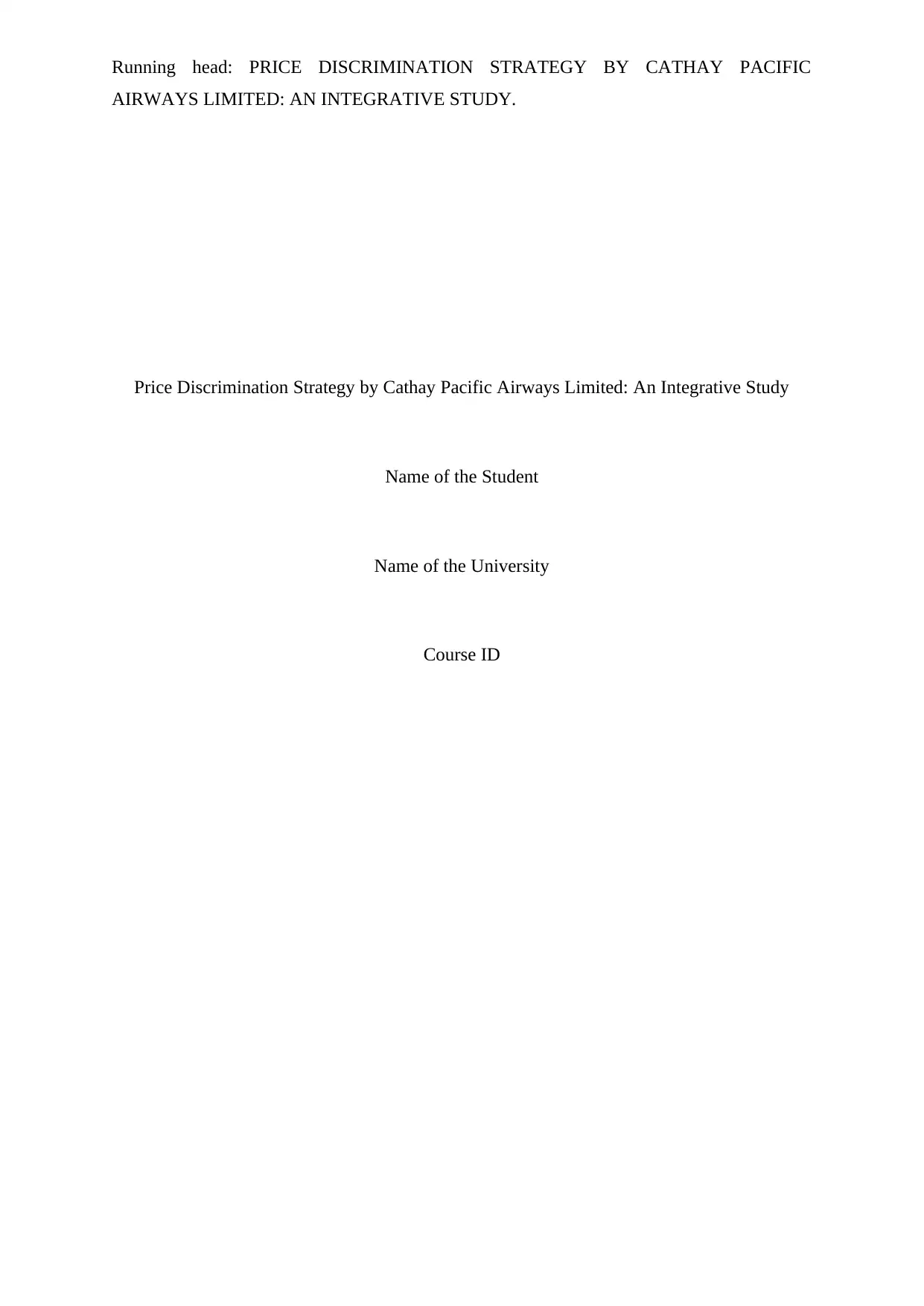
Running head: PRICE DISCRIMINATION STRATEGY BY CATHAY PACIFIC
AIRWAYS LIMITED: AN INTEGRATIVE STUDY.
Price Discrimination Strategy by Cathay Pacific Airways Limited: An Integrative Study
Name of the Student
Name of the University
Course ID
AIRWAYS LIMITED: AN INTEGRATIVE STUDY.
Price Discrimination Strategy by Cathay Pacific Airways Limited: An Integrative Study
Name of the Student
Name of the University
Course ID
Paraphrase This Document
Need a fresh take? Get an instant paraphrase of this document with our AI Paraphraser
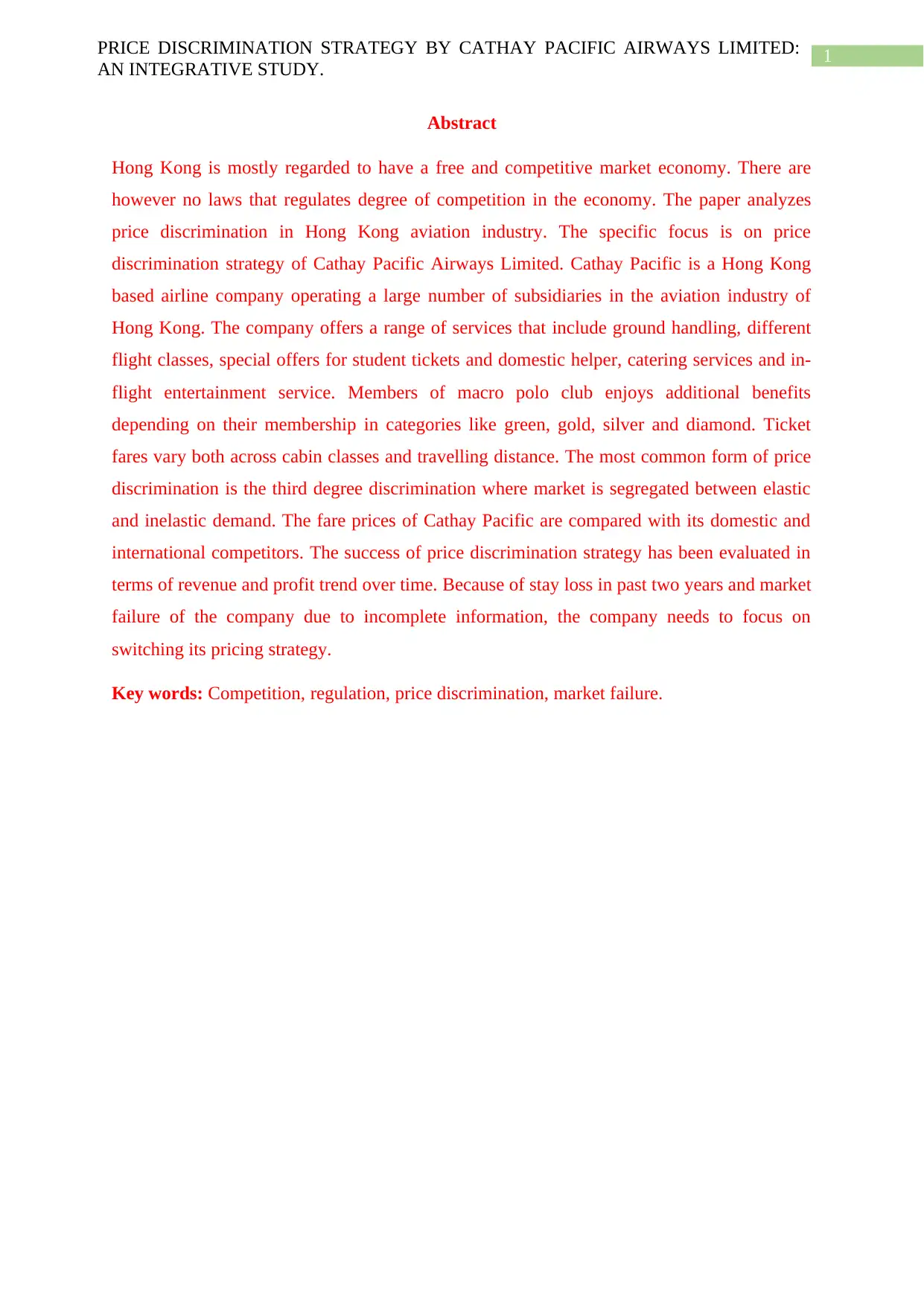
1PRICE DISCRIMINATION STRATEGY BY CATHAY PACIFIC AIRWAYS LIMITED:
AN INTEGRATIVE STUDY.
Abstract
Hong Kong is mostly regarded to have a free and competitive market economy. There are
however no laws that regulates degree of competition in the economy. The paper analyzes
price discrimination in Hong Kong aviation industry. The specific focus is on price
discrimination strategy of Cathay Pacific Airways Limited. Cathay Pacific is a Hong Kong
based airline company operating a large number of subsidiaries in the aviation industry of
Hong Kong. The company offers a range of services that include ground handling, different
flight classes, special offers for student tickets and domestic helper, catering services and in-
flight entertainment service. Members of macro polo club enjoys additional benefits
depending on their membership in categories like green, gold, silver and diamond. Ticket
fares vary both across cabin classes and travelling distance. The most common form of price
discrimination is the third degree discrimination where market is segregated between elastic
and inelastic demand. The fare prices of Cathay Pacific are compared with its domestic and
international competitors. The success of price discrimination strategy has been evaluated in
terms of revenue and profit trend over time. Because of stay loss in past two years and market
failure of the company due to incomplete information, the company needs to focus on
switching its pricing strategy.
Key words: Competition, regulation, price discrimination, market failure.
AN INTEGRATIVE STUDY.
Abstract
Hong Kong is mostly regarded to have a free and competitive market economy. There are
however no laws that regulates degree of competition in the economy. The paper analyzes
price discrimination in Hong Kong aviation industry. The specific focus is on price
discrimination strategy of Cathay Pacific Airways Limited. Cathay Pacific is a Hong Kong
based airline company operating a large number of subsidiaries in the aviation industry of
Hong Kong. The company offers a range of services that include ground handling, different
flight classes, special offers for student tickets and domestic helper, catering services and in-
flight entertainment service. Members of macro polo club enjoys additional benefits
depending on their membership in categories like green, gold, silver and diamond. Ticket
fares vary both across cabin classes and travelling distance. The most common form of price
discrimination is the third degree discrimination where market is segregated between elastic
and inelastic demand. The fare prices of Cathay Pacific are compared with its domestic and
international competitors. The success of price discrimination strategy has been evaluated in
terms of revenue and profit trend over time. Because of stay loss in past two years and market
failure of the company due to incomplete information, the company needs to focus on
switching its pricing strategy.
Key words: Competition, regulation, price discrimination, market failure.
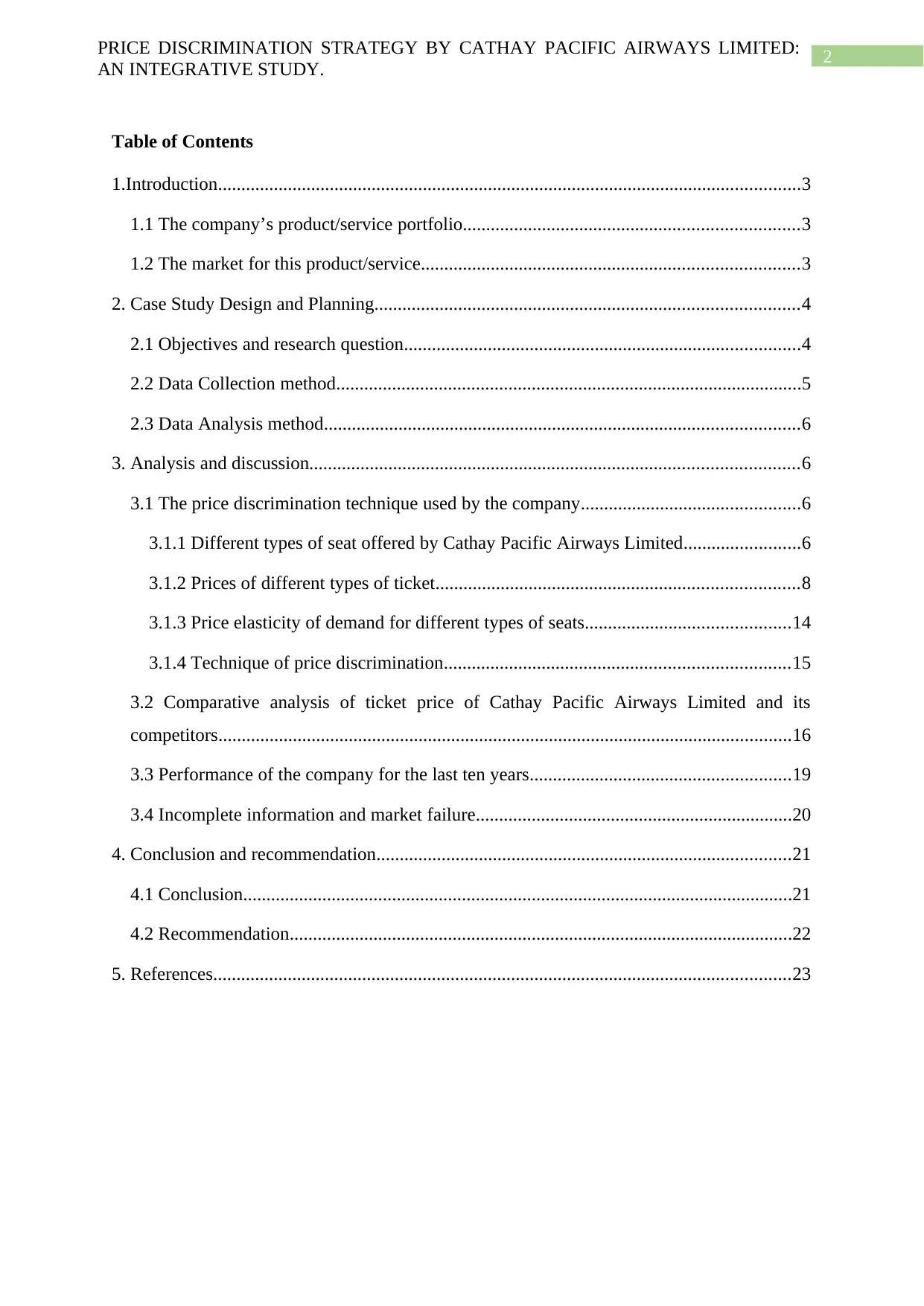
2PRICE DISCRIMINATION STRATEGY BY CATHAY PACIFIC AIRWAYS LIMITED:
AN INTEGRATIVE STUDY.
Table of Contents
1.Introduction.............................................................................................................................3
1.1 The company’s product/service portfolio........................................................................3
1.2 The market for this product/service.................................................................................3
2. Case Study Design and Planning...........................................................................................4
2.1 Objectives and research question.....................................................................................4
2.2 Data Collection method....................................................................................................5
2.3 Data Analysis method......................................................................................................6
3. Analysis and discussion.........................................................................................................6
3.1 The price discrimination technique used by the company...............................................6
3.1.1 Different types of seat offered by Cathay Pacific Airways Limited.........................6
3.1.2 Prices of different types of ticket..............................................................................8
3.1.3 Price elasticity of demand for different types of seats............................................14
3.1.4 Technique of price discrimination..........................................................................15
3.2 Comparative analysis of ticket price of Cathay Pacific Airways Limited and its
competitors...........................................................................................................................16
3.3 Performance of the company for the last ten years........................................................19
3.4 Incomplete information and market failure....................................................................20
4. Conclusion and recommendation.........................................................................................21
4.1 Conclusion......................................................................................................................21
4.2 Recommendation............................................................................................................22
5. References............................................................................................................................23
AN INTEGRATIVE STUDY.
Table of Contents
1.Introduction.............................................................................................................................3
1.1 The company’s product/service portfolio........................................................................3
1.2 The market for this product/service.................................................................................3
2. Case Study Design and Planning...........................................................................................4
2.1 Objectives and research question.....................................................................................4
2.2 Data Collection method....................................................................................................5
2.3 Data Analysis method......................................................................................................6
3. Analysis and discussion.........................................................................................................6
3.1 The price discrimination technique used by the company...............................................6
3.1.1 Different types of seat offered by Cathay Pacific Airways Limited.........................6
3.1.2 Prices of different types of ticket..............................................................................8
3.1.3 Price elasticity of demand for different types of seats............................................14
3.1.4 Technique of price discrimination..........................................................................15
3.2 Comparative analysis of ticket price of Cathay Pacific Airways Limited and its
competitors...........................................................................................................................16
3.3 Performance of the company for the last ten years........................................................19
3.4 Incomplete information and market failure....................................................................20
4. Conclusion and recommendation.........................................................................................21
4.1 Conclusion......................................................................................................................21
4.2 Recommendation............................................................................................................22
5. References............................................................................................................................23
⊘ This is a preview!⊘
Do you want full access?
Subscribe today to unlock all pages.

Trusted by 1+ million students worldwide
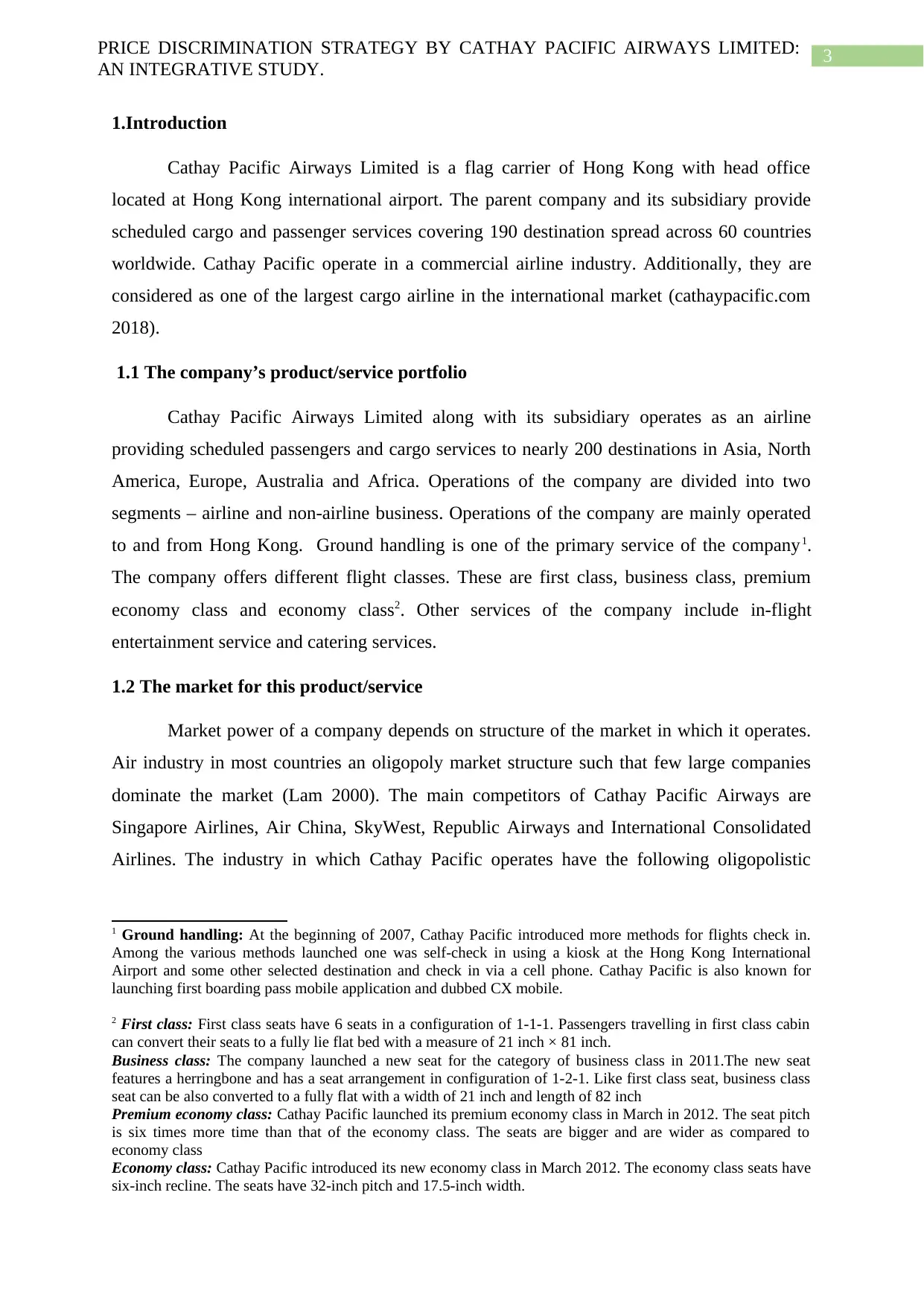
3PRICE DISCRIMINATION STRATEGY BY CATHAY PACIFIC AIRWAYS LIMITED:
AN INTEGRATIVE STUDY.
1.Introduction
Cathay Pacific Airways Limited is a flag carrier of Hong Kong with head office
located at Hong Kong international airport. The parent company and its subsidiary provide
scheduled cargo and passenger services covering 190 destination spread across 60 countries
worldwide. Cathay Pacific operate in a commercial airline industry. Additionally, they are
considered as one of the largest cargo airline in the international market (cathaypacific.com
2018).
1.1 The company’s product/service portfolio
Cathay Pacific Airways Limited along with its subsidiary operates as an airline
providing scheduled passengers and cargo services to nearly 200 destinations in Asia, North
America, Europe, Australia and Africa. Operations of the company are divided into two
segments – airline and non-airline business. Operations of the company are mainly operated
to and from Hong Kong. Ground handling is one of the primary service of the company1.
The company offers different flight classes. These are first class, business class, premium
economy class and economy class2. Other services of the company include in-flight
entertainment service and catering services.
1.2 The market for this product/service
Market power of a company depends on structure of the market in which it operates.
Air industry in most countries an oligopoly market structure such that few large companies
dominate the market (Lam 2000). The main competitors of Cathay Pacific Airways are
Singapore Airlines, Air China, SkyWest, Republic Airways and International Consolidated
Airlines. The industry in which Cathay Pacific operates have the following oligopolistic
1 Ground handling: At the beginning of 2007, Cathay Pacific introduced more methods for flights check in.
Among the various methods launched one was self-check in using a kiosk at the Hong Kong International
Airport and some other selected destination and check in via a cell phone. Cathay Pacific is also known for
launching first boarding pass mobile application and dubbed CX mobile.
2 First class: First class seats have 6 seats in a configuration of 1-1-1. Passengers travelling in first class cabin
can convert their seats to a fully lie flat bed with a measure of 21 inch × 81 inch.
Business class: The company launched a new seat for the category of business class in 2011.The new seat
features a herringbone and has a seat arrangement in configuration of 1-2-1. Like first class seat, business class
seat can be also converted to a fully flat with a width of 21 inch and length of 82 inch
Premium economy class: Cathay Pacific launched its premium economy class in March in 2012. The seat pitch
is six times more time than that of the economy class. The seats are bigger and are wider as compared to
economy class
Economy class: Cathay Pacific introduced its new economy class in March 2012. The economy class seats have
six-inch recline. The seats have 32-inch pitch and 17.5-inch width.
AN INTEGRATIVE STUDY.
1.Introduction
Cathay Pacific Airways Limited is a flag carrier of Hong Kong with head office
located at Hong Kong international airport. The parent company and its subsidiary provide
scheduled cargo and passenger services covering 190 destination spread across 60 countries
worldwide. Cathay Pacific operate in a commercial airline industry. Additionally, they are
considered as one of the largest cargo airline in the international market (cathaypacific.com
2018).
1.1 The company’s product/service portfolio
Cathay Pacific Airways Limited along with its subsidiary operates as an airline
providing scheduled passengers and cargo services to nearly 200 destinations in Asia, North
America, Europe, Australia and Africa. Operations of the company are divided into two
segments – airline and non-airline business. Operations of the company are mainly operated
to and from Hong Kong. Ground handling is one of the primary service of the company1.
The company offers different flight classes. These are first class, business class, premium
economy class and economy class2. Other services of the company include in-flight
entertainment service and catering services.
1.2 The market for this product/service
Market power of a company depends on structure of the market in which it operates.
Air industry in most countries an oligopoly market structure such that few large companies
dominate the market (Lam 2000). The main competitors of Cathay Pacific Airways are
Singapore Airlines, Air China, SkyWest, Republic Airways and International Consolidated
Airlines. The industry in which Cathay Pacific operates have the following oligopolistic
1 Ground handling: At the beginning of 2007, Cathay Pacific introduced more methods for flights check in.
Among the various methods launched one was self-check in using a kiosk at the Hong Kong International
Airport and some other selected destination and check in via a cell phone. Cathay Pacific is also known for
launching first boarding pass mobile application and dubbed CX mobile.
2 First class: First class seats have 6 seats in a configuration of 1-1-1. Passengers travelling in first class cabin
can convert their seats to a fully lie flat bed with a measure of 21 inch × 81 inch.
Business class: The company launched a new seat for the category of business class in 2011.The new seat
features a herringbone and has a seat arrangement in configuration of 1-2-1. Like first class seat, business class
seat can be also converted to a fully flat with a width of 21 inch and length of 82 inch
Premium economy class: Cathay Pacific launched its premium economy class in March in 2012. The seat pitch
is six times more time than that of the economy class. The seats are bigger and are wider as compared to
economy class
Economy class: Cathay Pacific introduced its new economy class in March 2012. The economy class seats have
six-inch recline. The seats have 32-inch pitch and 17.5-inch width.
Paraphrase This Document
Need a fresh take? Get an instant paraphrase of this document with our AI Paraphraser
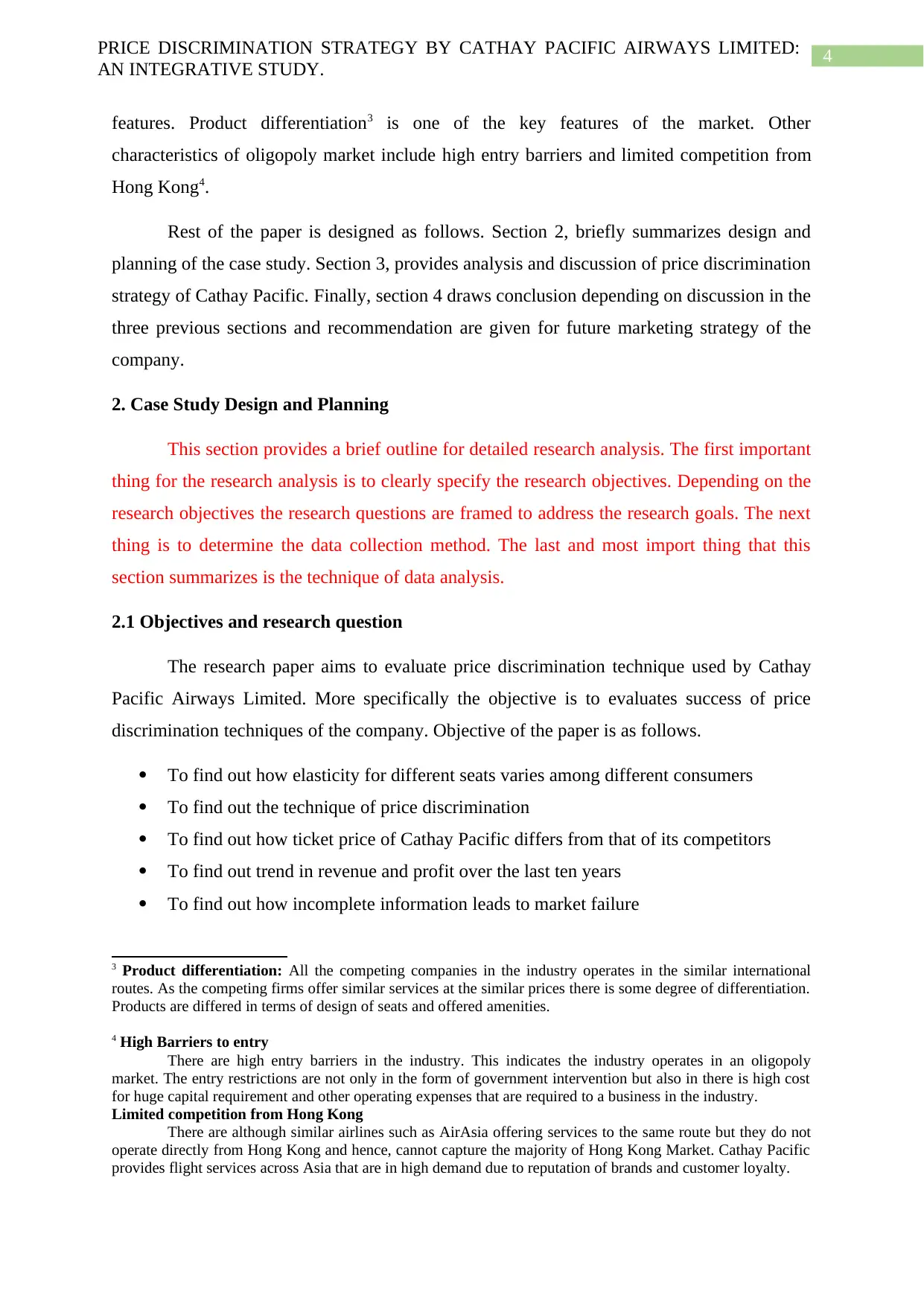
4PRICE DISCRIMINATION STRATEGY BY CATHAY PACIFIC AIRWAYS LIMITED:
AN INTEGRATIVE STUDY.
features. Product differentiation3 is one of the key features of the market. Other
characteristics of oligopoly market include high entry barriers and limited competition from
Hong Kong4.
Rest of the paper is designed as follows. Section 2, briefly summarizes design and
planning of the case study. Section 3, provides analysis and discussion of price discrimination
strategy of Cathay Pacific. Finally, section 4 draws conclusion depending on discussion in the
three previous sections and recommendation are given for future marketing strategy of the
company.
2. Case Study Design and Planning
This section provides a brief outline for detailed research analysis. The first important
thing for the research analysis is to clearly specify the research objectives. Depending on the
research objectives the research questions are framed to address the research goals. The next
thing is to determine the data collection method. The last and most import thing that this
section summarizes is the technique of data analysis.
2.1 Objectives and research question
The research paper aims to evaluate price discrimination technique used by Cathay
Pacific Airways Limited. More specifically the objective is to evaluates success of price
discrimination techniques of the company. Objective of the paper is as follows.
To find out how elasticity for different seats varies among different consumers
To find out the technique of price discrimination
To find out how ticket price of Cathay Pacific differs from that of its competitors
To find out trend in revenue and profit over the last ten years
To find out how incomplete information leads to market failure
3 Product differentiation: All the competing companies in the industry operates in the similar international
routes. As the competing firms offer similar services at the similar prices there is some degree of differentiation.
Products are differed in terms of design of seats and offered amenities.
4 High Barriers to entry
There are high entry barriers in the industry. This indicates the industry operates in an oligopoly
market. The entry restrictions are not only in the form of government intervention but also in there is high cost
for huge capital requirement and other operating expenses that are required to a business in the industry.
Limited competition from Hong Kong
There are although similar airlines such as AirAsia offering services to the same route but they do not
operate directly from Hong Kong and hence, cannot capture the majority of Hong Kong Market. Cathay Pacific
provides flight services across Asia that are in high demand due to reputation of brands and customer loyalty.
AN INTEGRATIVE STUDY.
features. Product differentiation3 is one of the key features of the market. Other
characteristics of oligopoly market include high entry barriers and limited competition from
Hong Kong4.
Rest of the paper is designed as follows. Section 2, briefly summarizes design and
planning of the case study. Section 3, provides analysis and discussion of price discrimination
strategy of Cathay Pacific. Finally, section 4 draws conclusion depending on discussion in the
three previous sections and recommendation are given for future marketing strategy of the
company.
2. Case Study Design and Planning
This section provides a brief outline for detailed research analysis. The first important
thing for the research analysis is to clearly specify the research objectives. Depending on the
research objectives the research questions are framed to address the research goals. The next
thing is to determine the data collection method. The last and most import thing that this
section summarizes is the technique of data analysis.
2.1 Objectives and research question
The research paper aims to evaluate price discrimination technique used by Cathay
Pacific Airways Limited. More specifically the objective is to evaluates success of price
discrimination techniques of the company. Objective of the paper is as follows.
To find out how elasticity for different seats varies among different consumers
To find out the technique of price discrimination
To find out how ticket price of Cathay Pacific differs from that of its competitors
To find out trend in revenue and profit over the last ten years
To find out how incomplete information leads to market failure
3 Product differentiation: All the competing companies in the industry operates in the similar international
routes. As the competing firms offer similar services at the similar prices there is some degree of differentiation.
Products are differed in terms of design of seats and offered amenities.
4 High Barriers to entry
There are high entry barriers in the industry. This indicates the industry operates in an oligopoly
market. The entry restrictions are not only in the form of government intervention but also in there is high cost
for huge capital requirement and other operating expenses that are required to a business in the industry.
Limited competition from Hong Kong
There are although similar airlines such as AirAsia offering services to the same route but they do not
operate directly from Hong Kong and hence, cannot capture the majority of Hong Kong Market. Cathay Pacific
provides flight services across Asia that are in high demand due to reputation of brands and customer loyalty.
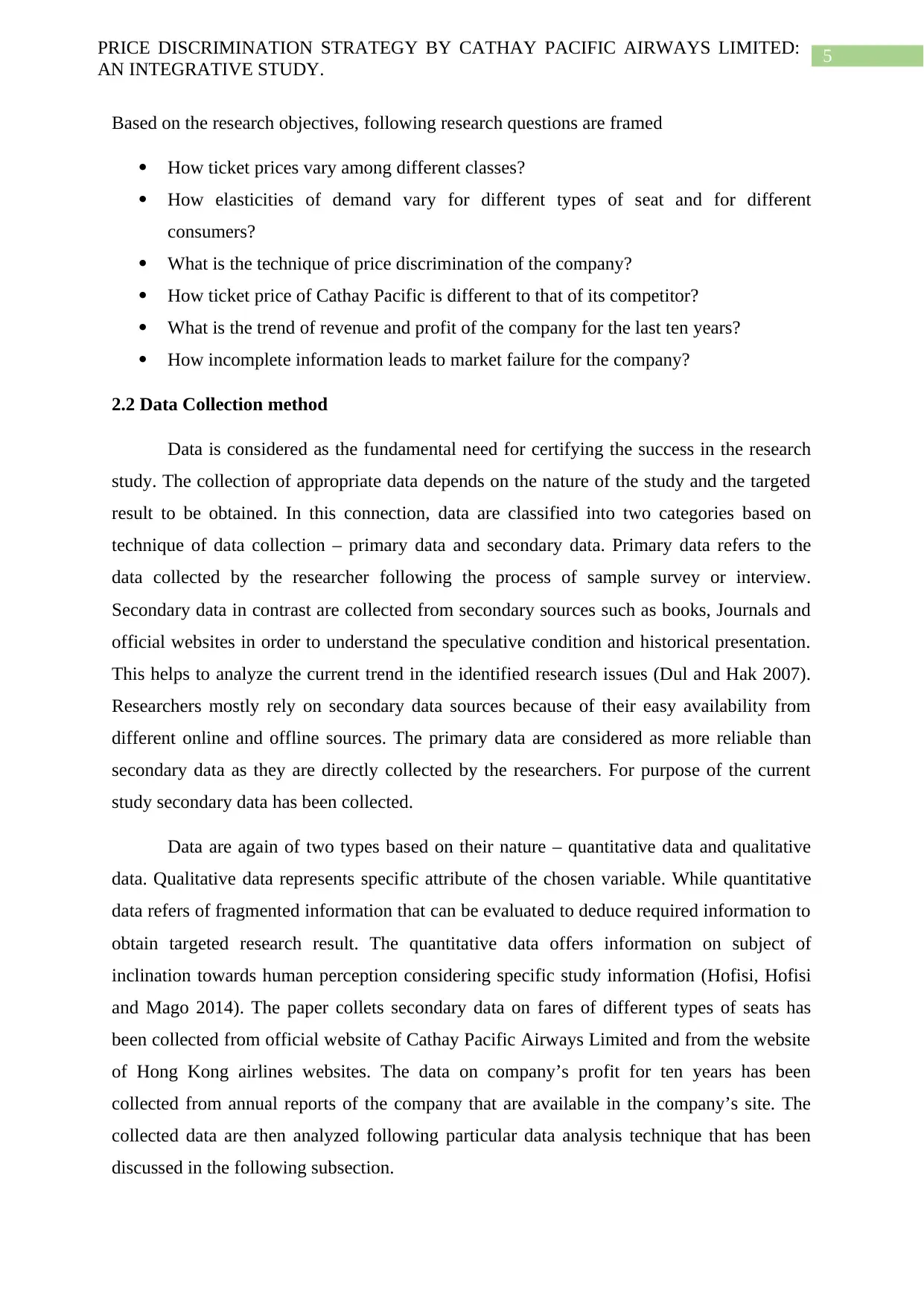
5PRICE DISCRIMINATION STRATEGY BY CATHAY PACIFIC AIRWAYS LIMITED:
AN INTEGRATIVE STUDY.
Based on the research objectives, following research questions are framed
How ticket prices vary among different classes?
How elasticities of demand vary for different types of seat and for different
consumers?
What is the technique of price discrimination of the company?
How ticket price of Cathay Pacific is different to that of its competitor?
What is the trend of revenue and profit of the company for the last ten years?
How incomplete information leads to market failure for the company?
2.2 Data Collection method
Data is considered as the fundamental need for certifying the success in the research
study. The collection of appropriate data depends on the nature of the study and the targeted
result to be obtained. In this connection, data are classified into two categories based on
technique of data collection – primary data and secondary data. Primary data refers to the
data collected by the researcher following the process of sample survey or interview.
Secondary data in contrast are collected from secondary sources such as books, Journals and
official websites in order to understand the speculative condition and historical presentation.
This helps to analyze the current trend in the identified research issues (Dul and Hak 2007).
Researchers mostly rely on secondary data sources because of their easy availability from
different online and offline sources. The primary data are considered as more reliable than
secondary data as they are directly collected by the researchers. For purpose of the current
study secondary data has been collected.
Data are again of two types based on their nature – quantitative data and qualitative
data. Qualitative data represents specific attribute of the chosen variable. While quantitative
data refers of fragmented information that can be evaluated to deduce required information to
obtain targeted research result. The quantitative data offers information on subject of
inclination towards human perception considering specific study information (Hofisi, Hofisi
and Mago 2014). The paper collets secondary data on fares of different types of seats has
been collected from official website of Cathay Pacific Airways Limited and from the website
of Hong Kong airlines websites. The data on company’s profit for ten years has been
collected from annual reports of the company that are available in the company’s site. The
collected data are then analyzed following particular data analysis technique that has been
discussed in the following subsection.
AN INTEGRATIVE STUDY.
Based on the research objectives, following research questions are framed
How ticket prices vary among different classes?
How elasticities of demand vary for different types of seat and for different
consumers?
What is the technique of price discrimination of the company?
How ticket price of Cathay Pacific is different to that of its competitor?
What is the trend of revenue and profit of the company for the last ten years?
How incomplete information leads to market failure for the company?
2.2 Data Collection method
Data is considered as the fundamental need for certifying the success in the research
study. The collection of appropriate data depends on the nature of the study and the targeted
result to be obtained. In this connection, data are classified into two categories based on
technique of data collection – primary data and secondary data. Primary data refers to the
data collected by the researcher following the process of sample survey or interview.
Secondary data in contrast are collected from secondary sources such as books, Journals and
official websites in order to understand the speculative condition and historical presentation.
This helps to analyze the current trend in the identified research issues (Dul and Hak 2007).
Researchers mostly rely on secondary data sources because of their easy availability from
different online and offline sources. The primary data are considered as more reliable than
secondary data as they are directly collected by the researchers. For purpose of the current
study secondary data has been collected.
Data are again of two types based on their nature – quantitative data and qualitative
data. Qualitative data represents specific attribute of the chosen variable. While quantitative
data refers of fragmented information that can be evaluated to deduce required information to
obtain targeted research result. The quantitative data offers information on subject of
inclination towards human perception considering specific study information (Hofisi, Hofisi
and Mago 2014). The paper collets secondary data on fares of different types of seats has
been collected from official website of Cathay Pacific Airways Limited and from the website
of Hong Kong airlines websites. The data on company’s profit for ten years has been
collected from annual reports of the company that are available in the company’s site. The
collected data are then analyzed following particular data analysis technique that has been
discussed in the following subsection.
⊘ This is a preview!⊘
Do you want full access?
Subscribe today to unlock all pages.

Trusted by 1+ million students worldwide
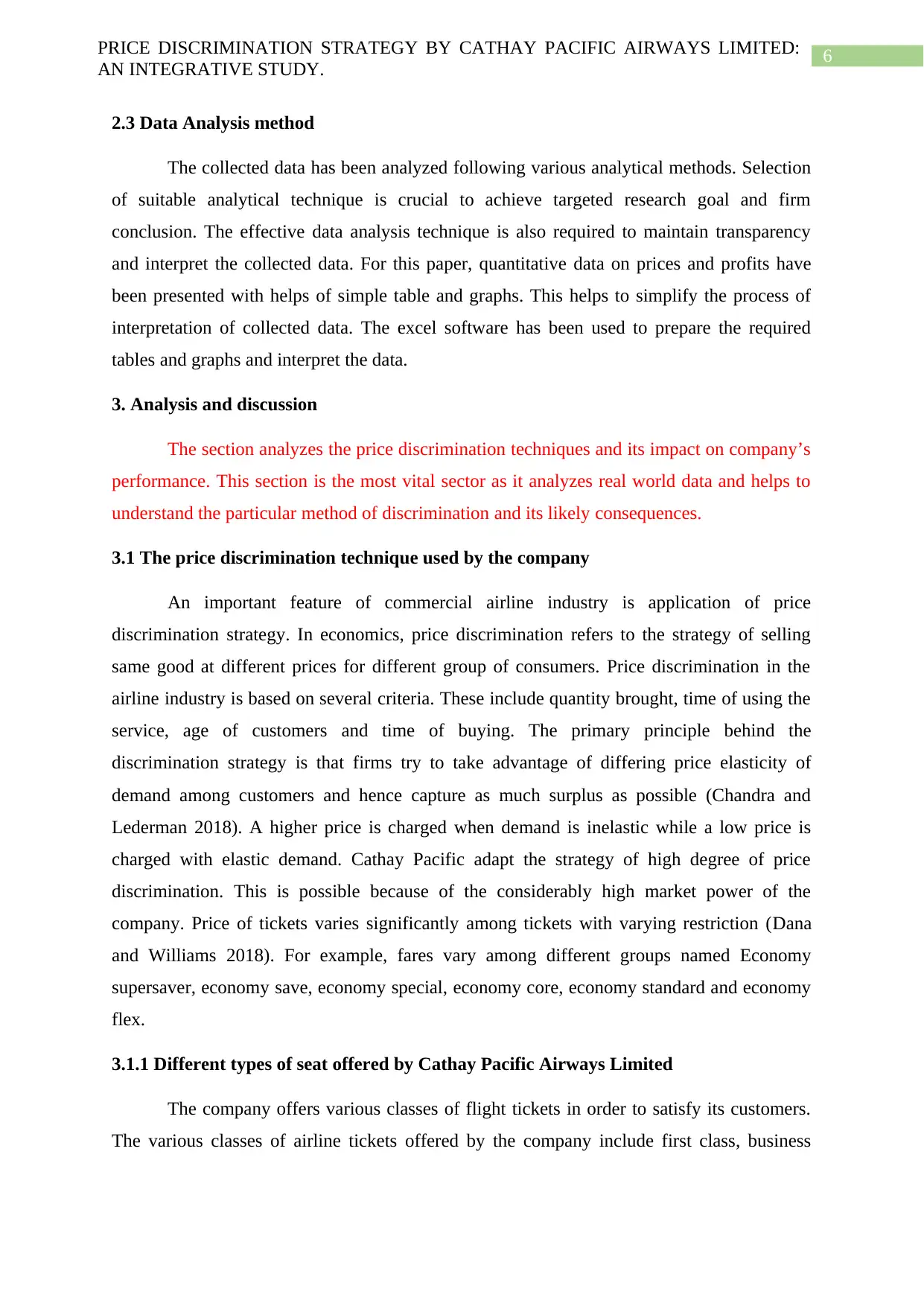
6PRICE DISCRIMINATION STRATEGY BY CATHAY PACIFIC AIRWAYS LIMITED:
AN INTEGRATIVE STUDY.
2.3 Data Analysis method
The collected data has been analyzed following various analytical methods. Selection
of suitable analytical technique is crucial to achieve targeted research goal and firm
conclusion. The effective data analysis technique is also required to maintain transparency
and interpret the collected data. For this paper, quantitative data on prices and profits have
been presented with helps of simple table and graphs. This helps to simplify the process of
interpretation of collected data. The excel software has been used to prepare the required
tables and graphs and interpret the data.
3. Analysis and discussion
The section analyzes the price discrimination techniques and its impact on company’s
performance. This section is the most vital sector as it analyzes real world data and helps to
understand the particular method of discrimination and its likely consequences.
3.1 The price discrimination technique used by the company
An important feature of commercial airline industry is application of price
discrimination strategy. In economics, price discrimination refers to the strategy of selling
same good at different prices for different group of consumers. Price discrimination in the
airline industry is based on several criteria. These include quantity brought, time of using the
service, age of customers and time of buying. The primary principle behind the
discrimination strategy is that firms try to take advantage of differing price elasticity of
demand among customers and hence capture as much surplus as possible (Chandra and
Lederman 2018). A higher price is charged when demand is inelastic while a low price is
charged with elastic demand. Cathay Pacific adapt the strategy of high degree of price
discrimination. This is possible because of the considerably high market power of the
company. Price of tickets varies significantly among tickets with varying restriction (Dana
and Williams 2018). For example, fares vary among different groups named Economy
supersaver, economy save, economy special, economy core, economy standard and economy
flex.
3.1.1 Different types of seat offered by Cathay Pacific Airways Limited
The company offers various classes of flight tickets in order to satisfy its customers.
The various classes of airline tickets offered by the company include first class, business
AN INTEGRATIVE STUDY.
2.3 Data Analysis method
The collected data has been analyzed following various analytical methods. Selection
of suitable analytical technique is crucial to achieve targeted research goal and firm
conclusion. The effective data analysis technique is also required to maintain transparency
and interpret the collected data. For this paper, quantitative data on prices and profits have
been presented with helps of simple table and graphs. This helps to simplify the process of
interpretation of collected data. The excel software has been used to prepare the required
tables and graphs and interpret the data.
3. Analysis and discussion
The section analyzes the price discrimination techniques and its impact on company’s
performance. This section is the most vital sector as it analyzes real world data and helps to
understand the particular method of discrimination and its likely consequences.
3.1 The price discrimination technique used by the company
An important feature of commercial airline industry is application of price
discrimination strategy. In economics, price discrimination refers to the strategy of selling
same good at different prices for different group of consumers. Price discrimination in the
airline industry is based on several criteria. These include quantity brought, time of using the
service, age of customers and time of buying. The primary principle behind the
discrimination strategy is that firms try to take advantage of differing price elasticity of
demand among customers and hence capture as much surplus as possible (Chandra and
Lederman 2018). A higher price is charged when demand is inelastic while a low price is
charged with elastic demand. Cathay Pacific adapt the strategy of high degree of price
discrimination. This is possible because of the considerably high market power of the
company. Price of tickets varies significantly among tickets with varying restriction (Dana
and Williams 2018). For example, fares vary among different groups named Economy
supersaver, economy save, economy special, economy core, economy standard and economy
flex.
3.1.1 Different types of seat offered by Cathay Pacific Airways Limited
The company offers various classes of flight tickets in order to satisfy its customers.
The various classes of airline tickets offered by the company include first class, business
Paraphrase This Document
Need a fresh take? Get an instant paraphrase of this document with our AI Paraphraser
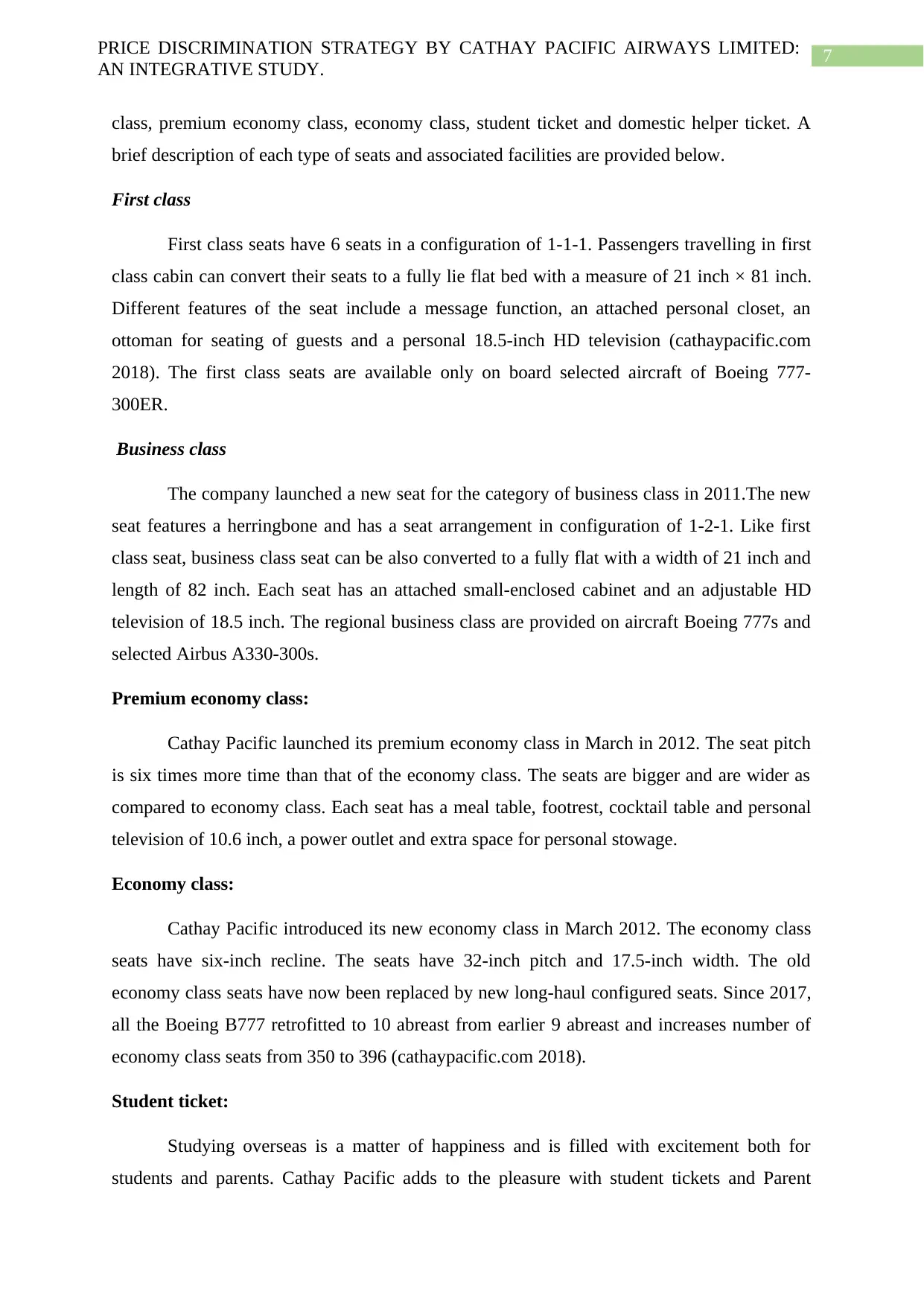
7PRICE DISCRIMINATION STRATEGY BY CATHAY PACIFIC AIRWAYS LIMITED:
AN INTEGRATIVE STUDY.
class, premium economy class, economy class, student ticket and domestic helper ticket. A
brief description of each type of seats and associated facilities are provided below.
First class
First class seats have 6 seats in a configuration of 1-1-1. Passengers travelling in first
class cabin can convert their seats to a fully lie flat bed with a measure of 21 inch × 81 inch.
Different features of the seat include a message function, an attached personal closet, an
ottoman for seating of guests and a personal 18.5-inch HD television (cathaypacific.com
2018). The first class seats are available only on board selected aircraft of Boeing 777-
300ER.
Business class
The company launched a new seat for the category of business class in 2011.The new
seat features a herringbone and has a seat arrangement in configuration of 1-2-1. Like first
class seat, business class seat can be also converted to a fully flat with a width of 21 inch and
length of 82 inch. Each seat has an attached small-enclosed cabinet and an adjustable HD
television of 18.5 inch. The regional business class are provided on aircraft Boeing 777s and
selected Airbus A330-300s.
Premium economy class:
Cathay Pacific launched its premium economy class in March in 2012. The seat pitch
is six times more time than that of the economy class. The seats are bigger and are wider as
compared to economy class. Each seat has a meal table, footrest, cocktail table and personal
television of 10.6 inch, a power outlet and extra space for personal stowage.
Economy class:
Cathay Pacific introduced its new economy class in March 2012. The economy class
seats have six-inch recline. The seats have 32-inch pitch and 17.5-inch width. The old
economy class seats have now been replaced by new long-haul configured seats. Since 2017,
all the Boeing B777 retrofitted to 10 abreast from earlier 9 abreast and increases number of
economy class seats from 350 to 396 (cathaypacific.com 2018).
Student ticket:
Studying overseas is a matter of happiness and is filled with excitement both for
students and parents. Cathay Pacific adds to the pleasure with student tickets and Parent
AN INTEGRATIVE STUDY.
class, premium economy class, economy class, student ticket and domestic helper ticket. A
brief description of each type of seats and associated facilities are provided below.
First class
First class seats have 6 seats in a configuration of 1-1-1. Passengers travelling in first
class cabin can convert their seats to a fully lie flat bed with a measure of 21 inch × 81 inch.
Different features of the seat include a message function, an attached personal closet, an
ottoman for seating of guests and a personal 18.5-inch HD television (cathaypacific.com
2018). The first class seats are available only on board selected aircraft of Boeing 777-
300ER.
Business class
The company launched a new seat for the category of business class in 2011.The new
seat features a herringbone and has a seat arrangement in configuration of 1-2-1. Like first
class seat, business class seat can be also converted to a fully flat with a width of 21 inch and
length of 82 inch. Each seat has an attached small-enclosed cabinet and an adjustable HD
television of 18.5 inch. The regional business class are provided on aircraft Boeing 777s and
selected Airbus A330-300s.
Premium economy class:
Cathay Pacific launched its premium economy class in March in 2012. The seat pitch
is six times more time than that of the economy class. The seats are bigger and are wider as
compared to economy class. Each seat has a meal table, footrest, cocktail table and personal
television of 10.6 inch, a power outlet and extra space for personal stowage.
Economy class:
Cathay Pacific introduced its new economy class in March 2012. The economy class
seats have six-inch recline. The seats have 32-inch pitch and 17.5-inch width. The old
economy class seats have now been replaced by new long-haul configured seats. Since 2017,
all the Boeing B777 retrofitted to 10 abreast from earlier 9 abreast and increases number of
economy class seats from 350 to 396 (cathaypacific.com 2018).
Student ticket:
Studying overseas is a matter of happiness and is filled with excitement both for
students and parents. Cathay Pacific adds to the pleasure with student tickets and Parent
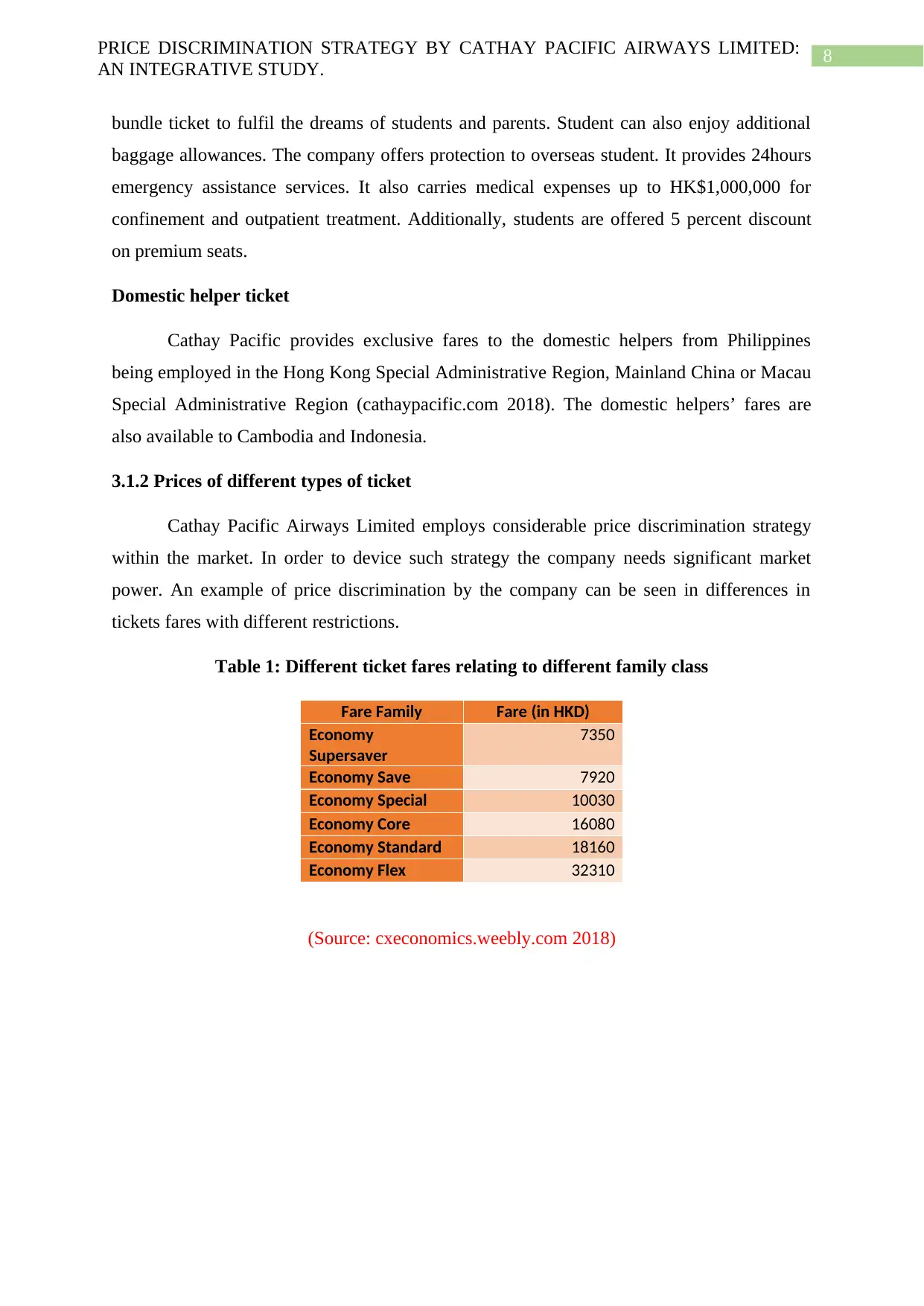
8PRICE DISCRIMINATION STRATEGY BY CATHAY PACIFIC AIRWAYS LIMITED:
AN INTEGRATIVE STUDY.
bundle ticket to fulfil the dreams of students and parents. Student can also enjoy additional
baggage allowances. The company offers protection to overseas student. It provides 24hours
emergency assistance services. It also carries medical expenses up to HK$1,000,000 for
confinement and outpatient treatment. Additionally, students are offered 5 percent discount
on premium seats.
Domestic helper ticket
Cathay Pacific provides exclusive fares to the domestic helpers from Philippines
being employed in the Hong Kong Special Administrative Region, Mainland China or Macau
Special Administrative Region (cathaypacific.com 2018). The domestic helpers’ fares are
also available to Cambodia and Indonesia.
3.1.2 Prices of different types of ticket
Cathay Pacific Airways Limited employs considerable price discrimination strategy
within the market. In order to device such strategy the company needs significant market
power. An example of price discrimination by the company can be seen in differences in
tickets fares with different restrictions.
Table 1: Different ticket fares relating to different family class
Fare Family Fare (in HKD)
Economy
Supersaver
7350
Economy Save 7920
Economy Special 10030
Economy Core 16080
Economy Standard 18160
Economy Flex 32310
(Source: cxeconomics.weebly.com 2018)
AN INTEGRATIVE STUDY.
bundle ticket to fulfil the dreams of students and parents. Student can also enjoy additional
baggage allowances. The company offers protection to overseas student. It provides 24hours
emergency assistance services. It also carries medical expenses up to HK$1,000,000 for
confinement and outpatient treatment. Additionally, students are offered 5 percent discount
on premium seats.
Domestic helper ticket
Cathay Pacific provides exclusive fares to the domestic helpers from Philippines
being employed in the Hong Kong Special Administrative Region, Mainland China or Macau
Special Administrative Region (cathaypacific.com 2018). The domestic helpers’ fares are
also available to Cambodia and Indonesia.
3.1.2 Prices of different types of ticket
Cathay Pacific Airways Limited employs considerable price discrimination strategy
within the market. In order to device such strategy the company needs significant market
power. An example of price discrimination by the company can be seen in differences in
tickets fares with different restrictions.
Table 1: Different ticket fares relating to different family class
Fare Family Fare (in HKD)
Economy
Supersaver
7350
Economy Save 7920
Economy Special 10030
Economy Core 16080
Economy Standard 18160
Economy Flex 32310
(Source: cxeconomics.weebly.com 2018)
⊘ This is a preview!⊘
Do you want full access?
Subscribe today to unlock all pages.

Trusted by 1+ million students worldwide
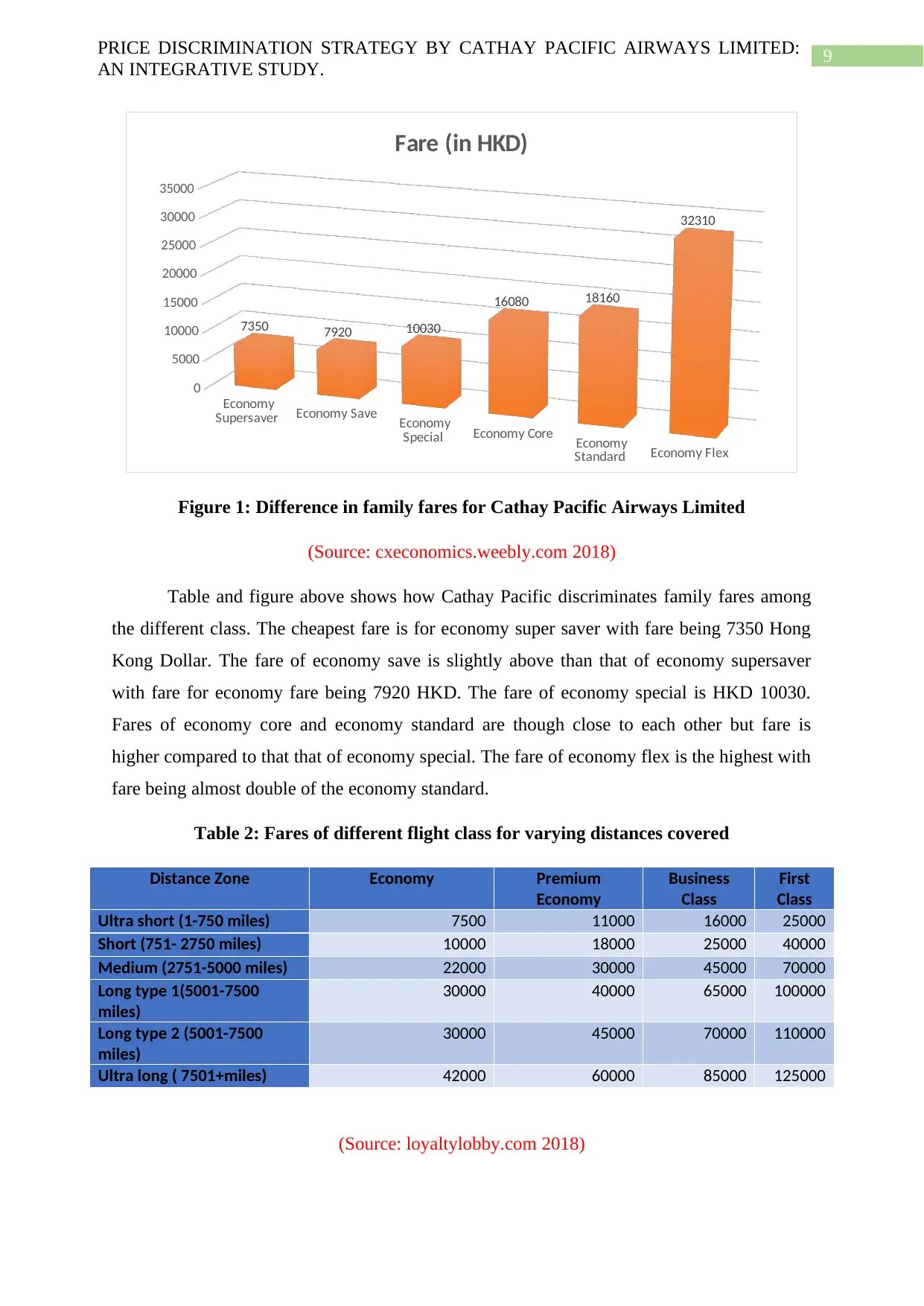
9PRICE DISCRIMINATION STRATEGY BY CATHAY PACIFIC AIRWAYS LIMITED:
AN INTEGRATIVE STUDY.
Economy
Supersaver Economy Save Economy
Special Economy Core Economy
Standard Economy Flex
0
5000
10000
15000
20000
25000
30000
35000
7350 7920 10030
16080 18160
32310
Fare (in HKD)
Figure 1: Difference in family fares for Cathay Pacific Airways Limited
(Source: cxeconomics.weebly.com 2018)
Table and figure above shows how Cathay Pacific discriminates family fares among
the different class. The cheapest fare is for economy super saver with fare being 7350 Hong
Kong Dollar. The fare of economy save is slightly above than that of economy supersaver
with fare for economy fare being 7920 HKD. The fare of economy special is HKD 10030.
Fares of economy core and economy standard are though close to each other but fare is
higher compared to that that of economy special. The fare of economy flex is the highest with
fare being almost double of the economy standard.
Table 2: Fares of different flight class for varying distances covered
Distance Zone Economy Premium
Economy
Business
Class
First
Class
Ultra short (1-750 miles) 7500 11000 16000 25000
Short (751- 2750 miles) 10000 18000 25000 40000
Medium (2751-5000 miles) 22000 30000 45000 70000
Long type 1(5001-7500
miles)
30000 40000 65000 100000
Long type 2 (5001-7500
miles)
30000 45000 70000 110000
Ultra long ( 7501+miles) 42000 60000 85000 125000
(Source: loyaltylobby.com 2018)
AN INTEGRATIVE STUDY.
Economy
Supersaver Economy Save Economy
Special Economy Core Economy
Standard Economy Flex
0
5000
10000
15000
20000
25000
30000
35000
7350 7920 10030
16080 18160
32310
Fare (in HKD)
Figure 1: Difference in family fares for Cathay Pacific Airways Limited
(Source: cxeconomics.weebly.com 2018)
Table and figure above shows how Cathay Pacific discriminates family fares among
the different class. The cheapest fare is for economy super saver with fare being 7350 Hong
Kong Dollar. The fare of economy save is slightly above than that of economy supersaver
with fare for economy fare being 7920 HKD. The fare of economy special is HKD 10030.
Fares of economy core and economy standard are though close to each other but fare is
higher compared to that that of economy special. The fare of economy flex is the highest with
fare being almost double of the economy standard.
Table 2: Fares of different flight class for varying distances covered
Distance Zone Economy Premium
Economy
Business
Class
First
Class
Ultra short (1-750 miles) 7500 11000 16000 25000
Short (751- 2750 miles) 10000 18000 25000 40000
Medium (2751-5000 miles) 22000 30000 45000 70000
Long type 1(5001-7500
miles)
30000 40000 65000 100000
Long type 2 (5001-7500
miles)
30000 45000 70000 110000
Ultra long ( 7501+miles) 42000 60000 85000 125000
(Source: loyaltylobby.com 2018)
Paraphrase This Document
Need a fresh take? Get an instant paraphrase of this document with our AI Paraphraser
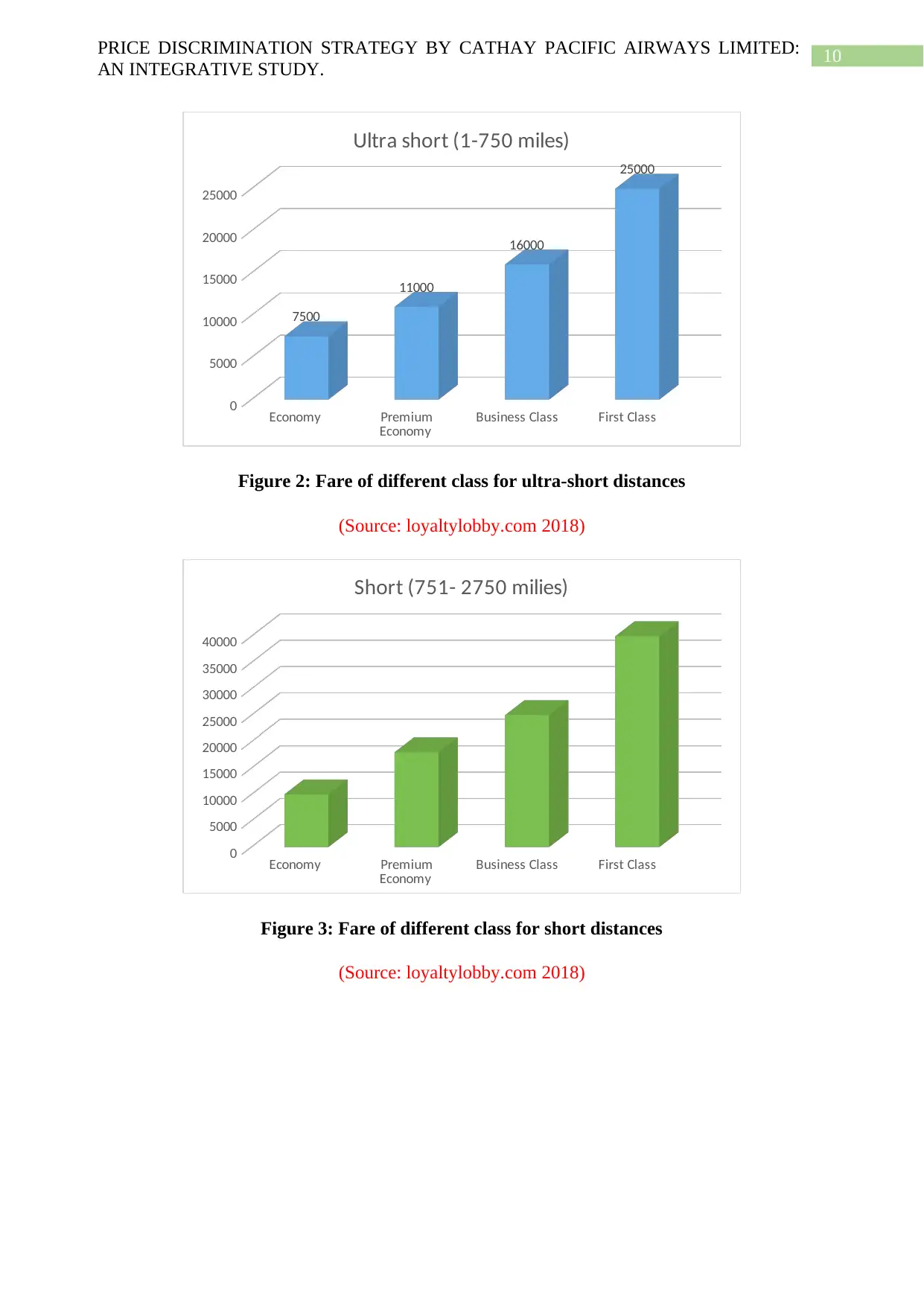
10PRICE DISCRIMINATION STRATEGY BY CATHAY PACIFIC AIRWAYS LIMITED:
AN INTEGRATIVE STUDY.
Economy Premium
Economy Business Class First Class
0
5000
10000
15000
20000
25000
7500
11000
16000
25000
Ultra short (1-750 miles)
Figure 2: Fare of different class for ultra-short distances
(Source: loyaltylobby.com 2018)
Economy Premium
Economy Business Class First Class
0
5000
10000
15000
20000
25000
30000
35000
40000
Short (751- 2750 milies)
Figure 3: Fare of different class for short distances
(Source: loyaltylobby.com 2018)
AN INTEGRATIVE STUDY.
Economy Premium
Economy Business Class First Class
0
5000
10000
15000
20000
25000
7500
11000
16000
25000
Ultra short (1-750 miles)
Figure 2: Fare of different class for ultra-short distances
(Source: loyaltylobby.com 2018)
Economy Premium
Economy Business Class First Class
0
5000
10000
15000
20000
25000
30000
35000
40000
Short (751- 2750 milies)
Figure 3: Fare of different class for short distances
(Source: loyaltylobby.com 2018)
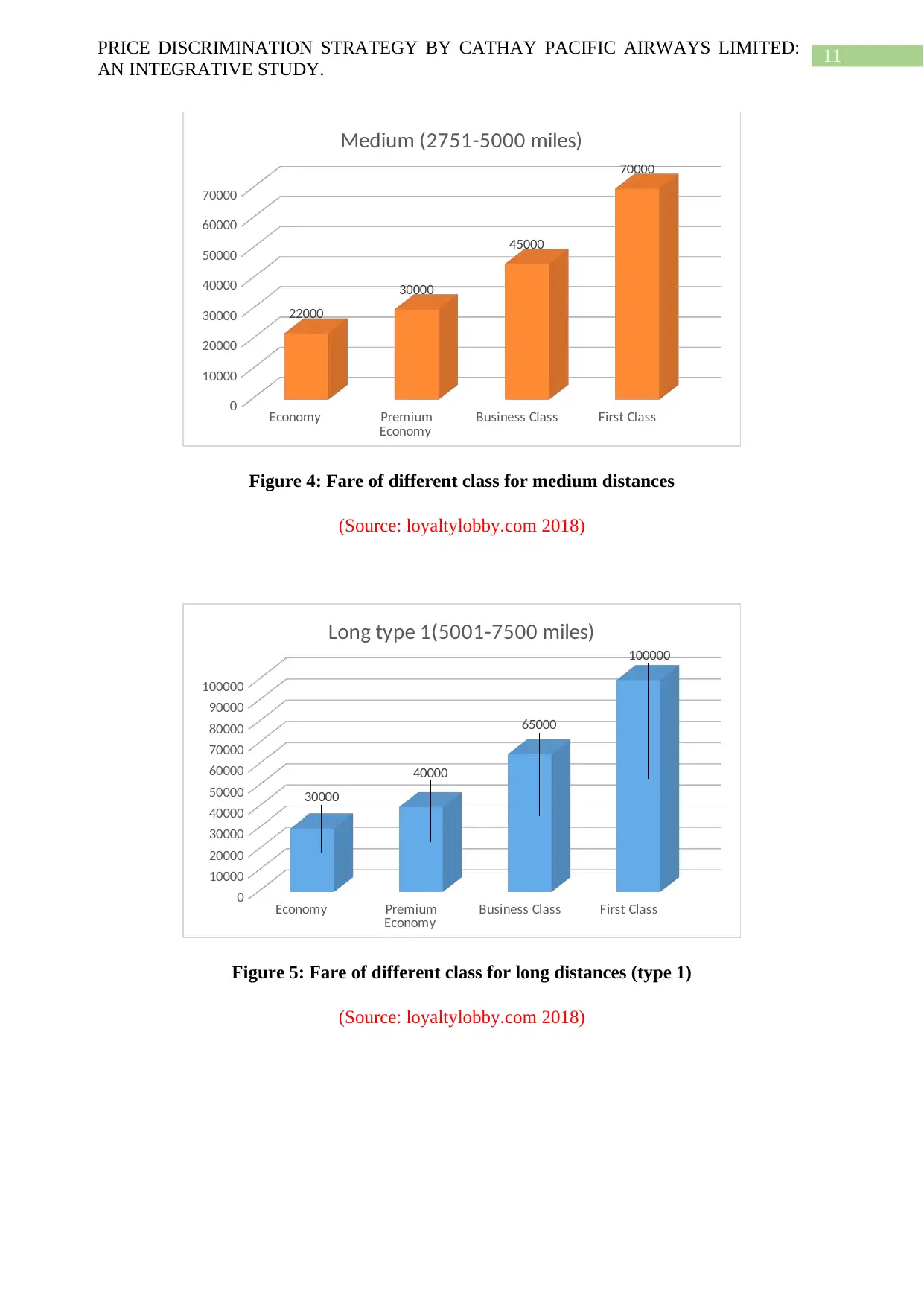
11PRICE DISCRIMINATION STRATEGY BY CATHAY PACIFIC AIRWAYS LIMITED:
AN INTEGRATIVE STUDY.
Economy Premium
Economy Business Class First Class
0
10000
20000
30000
40000
50000
60000
70000
22000
30000
45000
70000
Medium (2751-5000 miles)
Figure 4: Fare of different class for medium distances
(Source: loyaltylobby.com 2018)
Economy Premium
Economy Business Class First Class
0
10000
20000
30000
40000
50000
60000
70000
80000
90000
100000
30000
40000
65000
100000
Long type 1(5001-7500 miles)
Figure 5: Fare of different class for long distances (type 1)
(Source: loyaltylobby.com 2018)
AN INTEGRATIVE STUDY.
Economy Premium
Economy Business Class First Class
0
10000
20000
30000
40000
50000
60000
70000
22000
30000
45000
70000
Medium (2751-5000 miles)
Figure 4: Fare of different class for medium distances
(Source: loyaltylobby.com 2018)
Economy Premium
Economy Business Class First Class
0
10000
20000
30000
40000
50000
60000
70000
80000
90000
100000
30000
40000
65000
100000
Long type 1(5001-7500 miles)
Figure 5: Fare of different class for long distances (type 1)
(Source: loyaltylobby.com 2018)
⊘ This is a preview!⊘
Do you want full access?
Subscribe today to unlock all pages.

Trusted by 1+ million students worldwide
1 out of 26
Related Documents
Your All-in-One AI-Powered Toolkit for Academic Success.
+13062052269
info@desklib.com
Available 24*7 on WhatsApp / Email
![[object Object]](/_next/static/media/star-bottom.7253800d.svg)
Unlock your academic potential
Copyright © 2020–2025 A2Z Services. All Rights Reserved. Developed and managed by ZUCOL.




